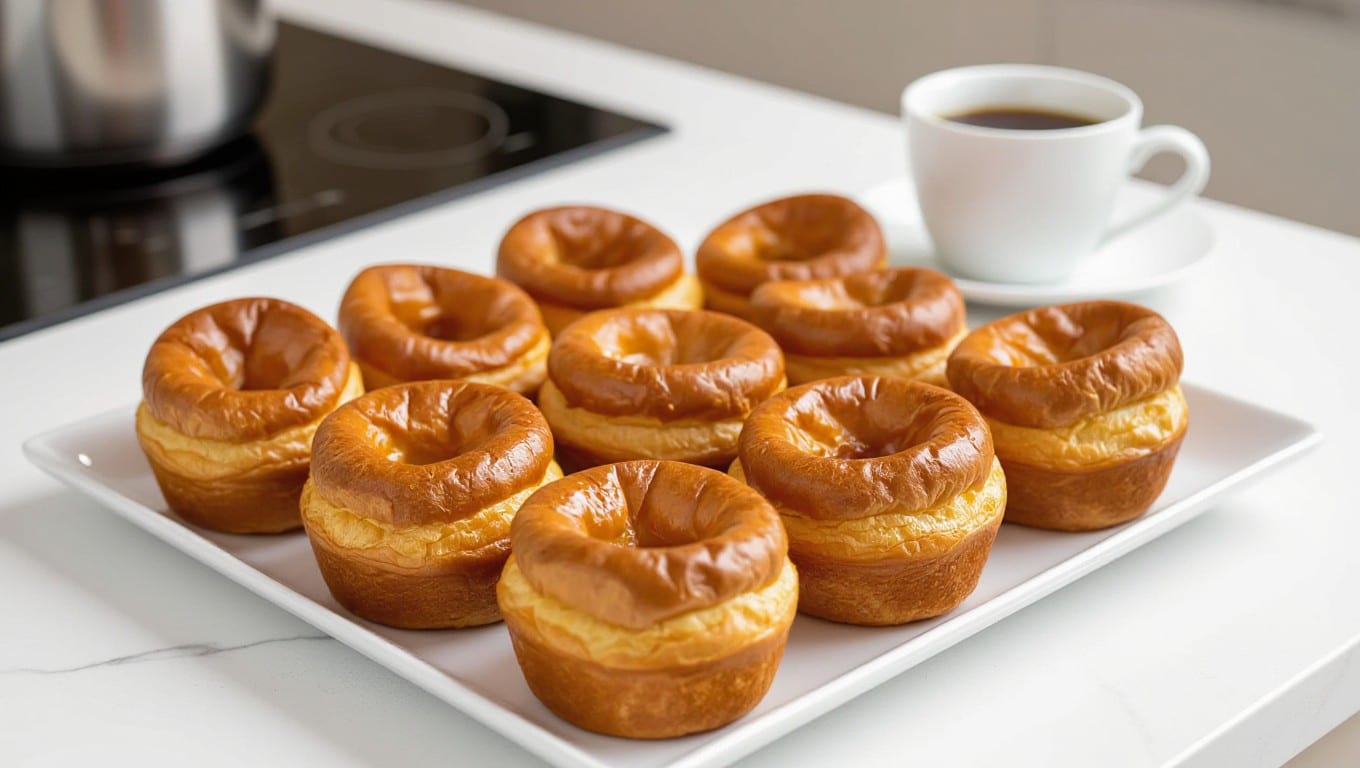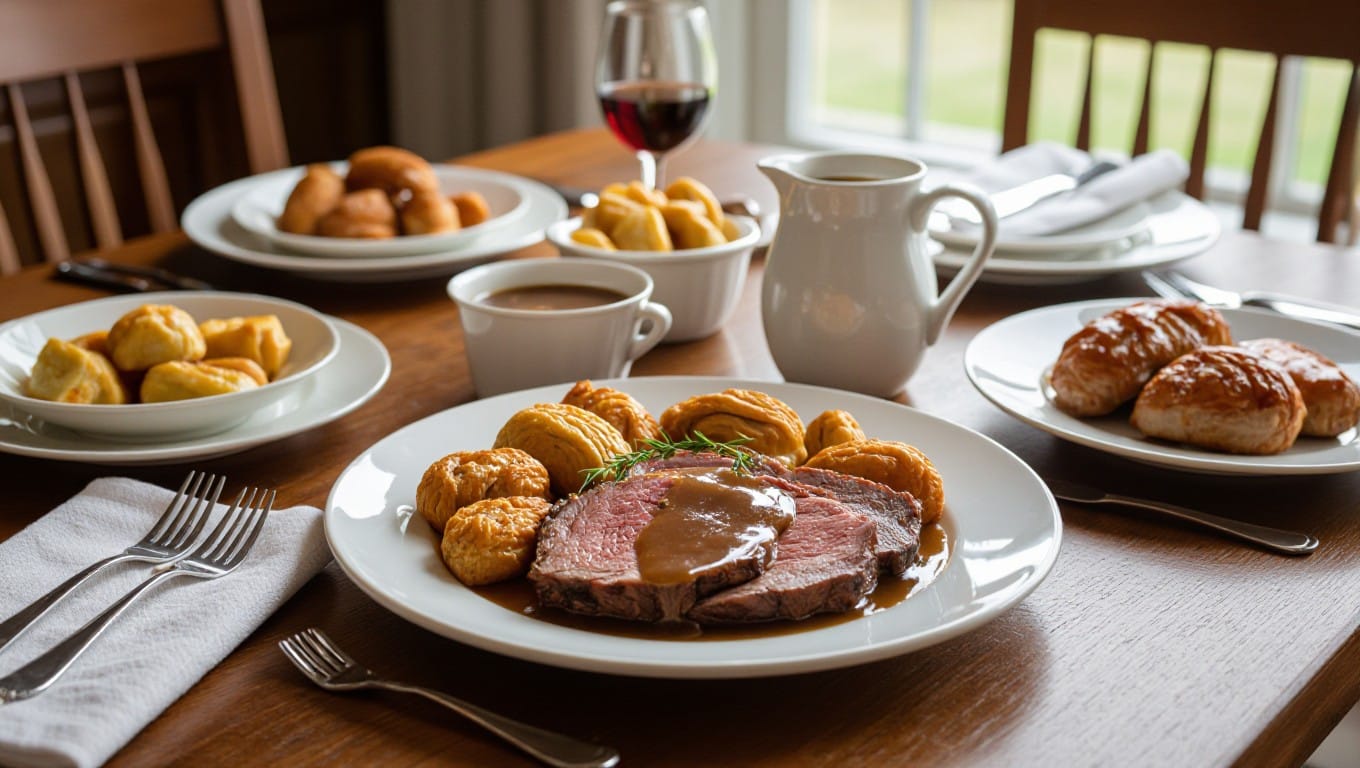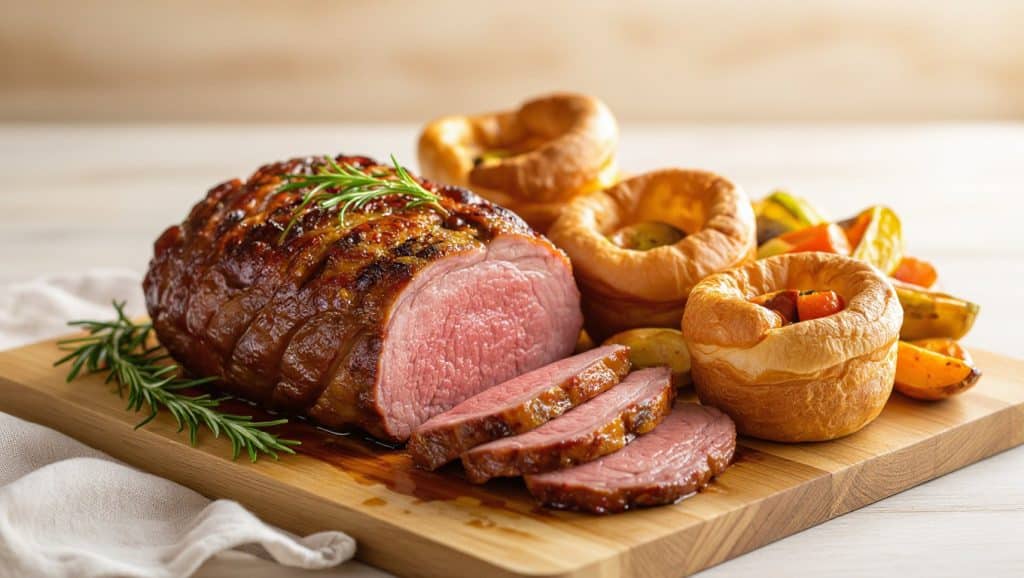Discover the magic of Jamie Oliver’s Roast Beef & Yorkshire Pudding Recipe, an ideal centerpiece for your Sunday roast dinner. This recipe not only features succulent roast beef, but also fluffy Yorkshire puddings that are sure to impress your guests. Start by selecting a premium rib of beef and allow it to come up to room temperature before cooking. As you prepare, remember to remove the beef from the fridge, drizzle it with oil, and generously season with salt and pepper for maximum flavor.
Once the beef is in the oven, don’t forget to baste the beef halfway through cooking to ensure it remains juicy and tender. For the Yorkshire puddings, make your batter by whisking the eggs and combining them with flour and milk. Pour the batter into a muffin tray or Yorkshire pudding tray that has been preheated with oil for that extra rise. In just a few minutes of cooking, you’ll achieve perfectly fluffy Yorkshire puddings that pair beautifully with the roast.
As the beef cooks for about an hour for medium beef, prepare to make the gravy using the delicious bone marrow from the roast. This will elevate your meal, making it a feast to remember. Serve your roast beef alongside the Yorkshire puddings, a selection of seasonal veg, and a dollop of horseradish for an authentic experience. Jamie’s recipes provide a delightful way to bring family and friends together around the table, ensuring that every Sunday feels special.
Selecting the Star: Choosing the Perfect Cut of Beef
To recreate Jamie Oliver’s Sunday roast beef masterpiece, choosing the right cut is vital. You’ll want a piece that offers both flavour and tenderness, capable of slow roasting to develop rich, juicy meat. Classic choices include ribeye for its marbled richness, sirloin for a leaner texture with a robust taste, or brisket for a melt-in-the-mouth finish when cooked low and slow. Opt for a joint that weighs around 1.5 to 2kg, ideal for feeding a family while allowing enough time for that golden crust and succulent inside you’re aiming for.
A Guide to Cuts: Ribeye vs. Sirloin vs. Brisket
Ribeye boasts excellent marbling, producing a tender and juicy roast with plenty of flavour from its fat content, best served medium rare. Sirloin offers a firmer texture, leaner with a bold beefy flavour, roasting beautifully for a slightly longer time and holding its shape well. Brisket, often slow-cooked, breaks down connective tissue for a tender, pull-apart roast ideal if you prefer a melt-in-the-mouth result, though it requires careful cooking to avoid drying out.
The Importance of Quality: Grass-fed vs. Grain-fed
Grass-fed beef typically provides a deeper, earthier flavour, benefited by a diet of fresh pasture, and often has lower fat content but higher omega-3s. Grain-fed beef tends to be more marbled with fat, producing a richer, buttery taste and a more tender texture thanks to its grain-enriched diet. Your choice influences cooking time and flavour profile, so consider your preferred taste and texture when selecting between the two.

Jamie Oliver’s Perfect Sunday Roast: Beef & Yorkshire Pudding Recipe
Prep: 30 min | Cook: 1 hr 5 min + resting | Serves: 6
Ingredients: topside of beef, root vegetables (onions, carrots, celery), garlic, herbs, eggs, milk, plain flour, beef dripping or oil
Method:
- Bring beef to room temp, season and roast at high heat, then lower to 200 °C/400°F for ~1 hr.
- Rest meat for 15–30 min before slicing thinly.
- Meanwhile, pour smoking hot fat into pudding tin wells, pour in batter and bake until risen and golden.
- Make gravy from roasting juices, bones and vegetables.
- Serve sliced roast beef with Yorkshire puddings, roast vegetables and gravy.
Timing is Key: Mastering the Roast
Precision in timing transforms your roast from good to exceptional. For a perfect Jamie Oliver Sunday roast beef, balancing oven temperature with cooking duration ensures tender, juicy results. A slow roast at 140°C (275°F) brings out deep flavors, while a final blast at high heat crisps the beef’s exterior. Yorkshire puddings demand swift, high heat to puff — the oven must be searing hot before they go in. Synchronizing these elements alongside your vegetables and gravy elevates the entire meal, making your Sunday roast a memorable family feast.
Calculating Cooking Times: The Rule of Thumb
Estimate approximately 20 minutes per 450g (1lb) for rare, 25 minutes per 450g for medium, and 30 minutes per 450g for well-done beef. For example, a 1.8kg (4lb) joint needs around 1 hour 20 minutes for medium-rare. Jamie Oliver often suggests lower-and-slower roasting styles, so you might add 10-15% extra time at 140°C to maintain tenderness without drying out. Use a reliable meat thermometer aiming for 50°C (122°F) internal for rare, 55-60°C (131-140°F) for medium, ensuring pinpoint accuracy.
Resting Periods: Why They Matter for Flavor and Texture
Once out of the oven, rest your beef for at least 20 minutes, tented loosely with foil. This pause redistributes juices, allowing them to reabsorb into the meat’s fibers rather than spilling out on carving. Resting also continues gentle cooking, raising the temperature slightly and softening muscle fibers—resulting in a tender, flavorful bite. Yorkshire puddings bake during this time, making the process seamless.
Diving deeper into resting, this step can increase the juiciness by up to 15%, according to culinary studies. When muscle fibers relax, they hold more moisture, preventing dryness. For larger joints over 2kg (4.5lb), extend resting to 30 minutes to maximize tenderness. During this, keep your roast covered but avoid tightly wrapping it, as trapped steam can soften the crust. Investing this short wait enhances every mouthful, making your roast truly worthy of a Jamie Oliver Sunday tradition.
The Art of Yorkshire Pudding: Foolproof Techniques
Getting Yorkshire puddings to puff up perfectly can transform your Sunday roast from good to spectacular. Achieving that golden, crispy exterior and soft, airy interior comes down to precision in batter consistency, oven heat, and pan readiness. Using a hot, oiled tray and pouring the batter swiftly into searing fat leads to dramatic, theatrical rises every time. Master these techniques, and you’ll impress family or guests with puddings that have that iconic craggy texture and irresistible crunch, true to Jamie Oliver’s style.
Two Key Ingredients for Puff Perfection
The secret behind beautiful Yorkshire puddings rests on just two simple ingredients: a balanced mix of eggs and flour, and the sizzling hot fat in your tin. Using equal volumes of eggs, milk, and flour creates a batter with the perfect texture to rise. Meanwhile, having your oil or beef dripping smoking hot in each compartment just before pouring ensures the batter reacts instantly, producing the characteristic rise and golden crust that defines a perfect Yorkshire pudding.
Timings and Temperatures: Your Ultimate Guide
High and steady heat is your ally for well-risen Yorkshire puddings. Bake at 220°C (425°F) on the top oven rack to maximize heat from above, encouraging a rapid puff. After pouring the batter, give the puddings about 20-25 minutes undisturbed—do not open the oven door early or they’ll deflate. Lower temperatures will cause them to collapse or turn doughy, while too high risks burning. The goal is a crisp, golden exterior with a tender, airy inside.
Timings and Temperatures for Yorkshire Puddings
| Step | Details |
|---|---|
| Oven temperature | 220°C (425°F), preferably top rack for intense heat |
| Preheat oil | Heat oil or beef dripping until smoking hot (about 5 minutes) |
| Bake time | 20-25 minutes, avoid opening oven door early |
| Resting | Serve immediately for best texture; Yorkshire puddings deflate as they cool |
Consistency in these timings and temperatures allows the batter’s steam to expand rapidly, creating those beloved Yorkshire pudding “windows” and craters. Opting for beef dripping from your roast beef pan adds authentic flavor, while vegetable oil works fine as a budget-friendly alternative. With a confident eye on heat levels and careful timing, your Yorkshire puddings become a standout centerpiece alongside your Sunday roast beef.
Gravy Magic: From Pan Drippings to Flavor Explosion
The secret to unforgettable gravy lies in those golden pan drippings left after roasting your beef. Scrape them up, deglaze the roasting tray with red wine or beef stock, then gently whisk in a roux to create a silky, rich sauce. This base captures all the roast’s savory essence, elevating your gravy to a true flavor explosion that ties the whole meal together, from tender beef slices to crisp Yorkshire puddings.
Building Blocks of a Rich Gravy: Stock, Flour, and Seasoning
Start with a good-quality beef stock, ideally homemade or low-sodium to control seasoning. Incorporate flour by forming a roux—equal parts flour and fat from your roasting juices—cooked until golden to thicken the gravy smoothly. Season with black pepper, a pinch of thyme, or a splash of Worcestershire sauce to deepen flavor. This balance ensures your gravy complements rather than overpowers the beef and vegetables.
Variations on a Classic: Adding Depth and Dimension
Enhance your gravy by adding sautéed shallots, a splash of balsamic vinegar, or fresh herbs like rosemary for an earthy note. Stirring in a teaspoon of mustard or a knob of butter just before serving can add silkiness and complexity. These simple twists transform the traditional gravy into something spectacular, offering subtle layers of flavor depending on the mood of your meal.

Seasonal Sides: Elevating Your Sunday Roast
Your Sunday roast deserves vibrant and hearty sides that complement the rich flavors of the beef and Yorkshire pudding. Using seasonal vegetables not only enhances freshness but also adds a burst of natural sweetness and texture. Think honey-glazed carrots, crisp roasted parsnips, or tender broccoli tossed in garlic butter. A medley of these colorful, nutrient-packed vegetables brings balance to the plate and offers visual appeal, elevating the entire meal experience. Don’t hesitate to swap in root vegetables in winter or lighter greens in spring to keep your feast perfectly attuned to the season.
Must-Have Vegetables: Choosing Seasonal Produce
Carrots, parsnips, Brussels sprouts, and red cabbage are classics that shine during colder months, roasting beautifully with a touch of olive oil and fresh herbs. In warmer seasons, asparagus, peas, and tender green beans provide crisp freshness and vibrant color. Opting for seasonal, locally sourced vegetables ensures peak flavor and nutritional value. Selecting produce at its prime guarantees your sides won’t steal the spotlight but perfectly support your roast beef and Yorkshire pudding with texture and subtle sweetness.
Prep Ahead: Make-Ahead Sides for Stress-Free Cooking
Many vegetable sides respond exceptionally well to make-ahead preparation, allowing you to free up oven space and avoid last-minute rushes. Parboil root vegetables like potatoes or parsnips early, then roast them close to serving time for maximum crispness. Elements such as red cabbage braises or glazed carrots can be prepared a day in advance and gently reheated. Juggling your timeline with these minimal effort strategies gives you breathing room on the day, ensuring every component arrives hot and perfectly cooked.
Dedicating time to prepare sides ahead can transform your cooking rhythm. For example, roasting potatoes until nearly done, then refreshing their crispness in a hot oven just before serving results in fluffy interiors and crunchy exteriors. Meanwhile, sauces and vegetable purees can simmer quietly on the stove or in a slow cooker, releasing flavors while you focus on the roast. This approach not only reduces oven congestion but also allows you to pace the cooking smoothly, keeping your Sunday roast calm, coordinated, and spectacularly satisfying.
[VIDEO] How To Make Yorkshire Puddings by Jamie Oliver
To wrap up
The perfect Sunday roast comes to life when you choose the right beef cut and master Yorkshire puddings, just like in Jamie Oliver’s Sunday roast beef recipe with Yorkshire pudding. By following precise cooking times and simple prep tips, you’ll create a meal that’s both traditional and impressive. Your gravy and vegetable choices can add delightful variations, ensuring your family feast is both flavorful and memorable. With a little planning and attention, you’ll enjoy a classic Sunday roast that brings everyone together around the table.
Frequently Asked Questions
How do I get perfectly risen Yorkshire puddings?
Ensure the fat is smoking hot, use a rested batter, and don’t open the oven door until baking is complete.
How long should the beef rest before carving?
Rest the beef under foil and a towel for about 15–30 minutes to keep it juicy and tender.
Can I prepare Yorkshire pudding batter in advance?
Yes. It’s best to whisk the batter the night before and chill it overnight. Bring it to room temperature before baking.
What cut of beef does Jamie recommend?
Jamie recommends topside of beef, but sirloin or rib roast also work beautifully for a classic Sunday roast.
What temperature should I roast the beef at?
Start at 240 °C/475 °F to sear, then reduce to 200 °C/400 °F and roast for about 1 hour for medium doneness.

